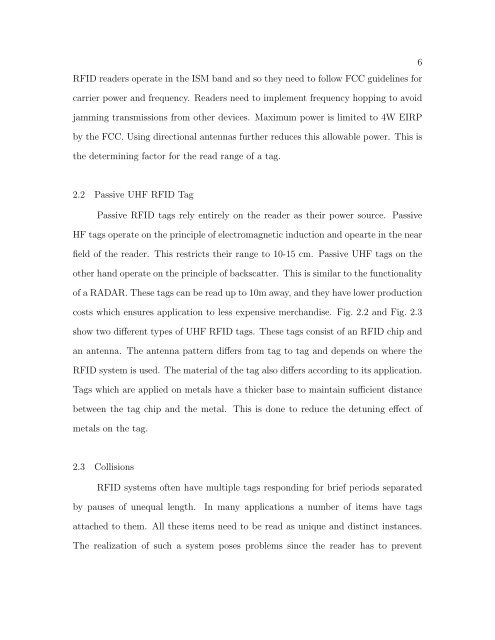utilizing physical layer information to improve rfid tag
utilizing physical layer information to improve rfid tag
utilizing physical layer information to improve rfid tag
Create successful ePaper yourself
Turn your PDF publications into a flip-book with our unique Google optimized e-Paper software.
RFID readers operate in the ISM band and so they need <strong>to</strong> follow FCC guidelines for<br />
carrier power and frequency. Readers need <strong>to</strong> implement frequency hopping <strong>to</strong> avoid<br />
jamming transmissions from other devices. Maximum power is limited <strong>to</strong> 4W EIRP<br />
by the FCC. Using directional antennas further reduces this allowable power. This is<br />
the determining fac<strong>to</strong>r for the read range of a <strong>tag</strong>.<br />
2.2 Passive UHF RFID Tag<br />
Passive RFID <strong>tag</strong>s rely entirely on the reader as their power source. Passive<br />
HF <strong>tag</strong>s operate on the principle of electromagnetic induction and opearte in the near<br />
field of the reader. This restricts their range <strong>to</strong> 10-15 cm. Passive UHF <strong>tag</strong>s on the<br />
other hand operate on the principle of backscatter. This is similar <strong>to</strong> the functionality<br />
of a RADAR. These <strong>tag</strong>s can be read up <strong>to</strong> 10m away, and they have lower production<br />
costs which ensures application <strong>to</strong> less expensive merchandise. Fig. 2.2 and Fig. 2.3<br />
show two different types of UHF RFID <strong>tag</strong>s. These <strong>tag</strong>s consist of an RFID chip and<br />
an antenna. The antenna pattern differs from <strong>tag</strong> <strong>to</strong> <strong>tag</strong> and depends on where the<br />
RFID system is used. The material of the <strong>tag</strong> also differs according <strong>to</strong> its application.<br />
Tags which are applied on metals have a thicker base <strong>to</strong> maintain sufficient distance<br />
between the <strong>tag</strong> chip and the metal. This is done <strong>to</strong> reduce the detuning effect of<br />
metals on the <strong>tag</strong>.<br />
2.3 Collisions<br />
RFID systems often have multiple <strong>tag</strong>s responding for brief periods separated<br />
by pauses of unequal length. In many applications a number of items have <strong>tag</strong>s<br />
attached <strong>to</strong> them. All these items need <strong>to</strong> be read as unique and distinct instances.<br />
The realization of such a system poses problems since the reader has <strong>to</strong> prevent<br />
6
















